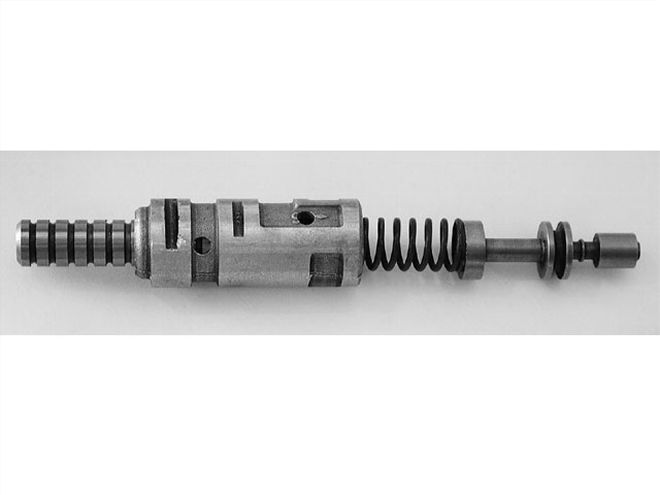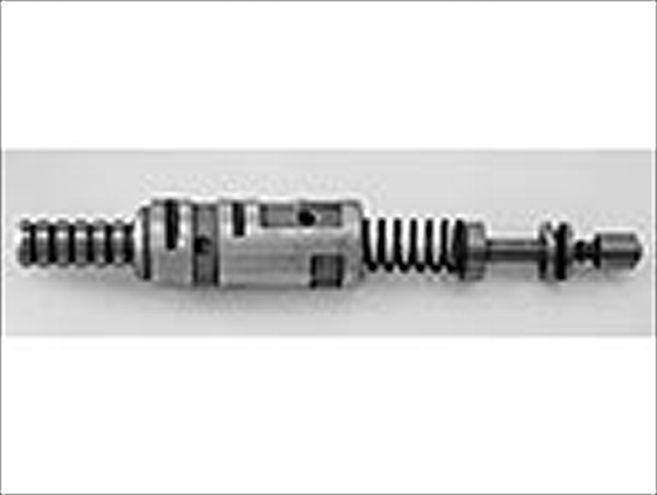


When the idea first came up to write this article, we wanted to call it "Adjusting a TV Cable the Right Way." After digging into the subject and spending some time at Bowtie Overdrives in Hesperia, California, we reevaluated the scope of this story and concluded that our first idea was far too simplistic. This story demanded a brief explanation of throttle-valve function in order to better understand its importance.
If you have a GM automatic overdrive transmission, then you should be familiar with the TV cable. You may also know that an improperly adjusted TV cable can be disastrous to a transmission's life span. First, let's define the term. TV stands for throttle valve, which refers to a small valve in the automatic transmission that determines hydraulic line pressure. This valve is hooked via a cable mechanism to the throttle linkage. As the throttle opens, the cable is pulled out of the transmission, signaling the transmission to increase line pressure to accommodate the additional torque. TV cable position also determines shift quality and firmness and controls all shift timing events. For GM cars, the TV cable is used on the popular TH200-4R and TH700-R4 automatic-overdrive transmissions. This is not the same as the kickdown linkage used on a TH350 transmission.
The bottom line is that the GM overdrive transmissions are inherently good gearboxes. But they seem to have an increasingly bad reputation for failure that can often be traced back to a poor TV-cable setup that leads to an early failure. When this happens, the blame usually lands on the transmission builder when the truth is that the TV-cable system was installed improperly, leading to low line pressure and early failure. If you read and follow the information in this story, it could save you the grief and expense of an overdrive transmission failure.
The TV Feed OrificeThis small orifice in the transmission's valvebody is one of the primary lines of communication to the transmission, aside from the shift-selector shaft that puts the trans in the right gear. The TV feed orifice is a common system that is shared between both the TH200-4R and the TH700-R4 and their variants. The critical issue here is the positioning of the TV valve at idle. The TV valve should sit right at the edge of the feed orifice at idle and completely uncover the orifice at wide-open throttle (WOT), thereby raising the pressure in the transmission.
The throttle-valve spring is what helps determine the position of the throttle valve at idle and therefore controls the pressure. The throttle valve is the virtual gatekeeper. When the spring becomes worn after thousands of cycles, it will not respond to part-throttle inputs, and the pressure may not match the engine's output. No amount of TV-cable adjustment can account for or correct for a worn spring. It must be replaced for proper throttle-valve function. It sounds crazy, but the life of your transmission relies on this small piece of coiled wire. If, for example, the throttle valve does not respond before wide-open throttle, any increase in torque output will probably damage the trans due to insufficient line pressure to handle this torque increase.
Diagnosing Throttle-Valve FunctionBoth the TH200-4R and TH700-R4 are equipped with an external pressure port (see photo) located on the driver side of the transmission case. A pressure gauge can be fitted to the port once the plug is removed to see if your TV is functioning properly. At idle, the gauge should read between 55 and 65 psi if the throttle valve is properly adjusted, assuming that your transmission is healthy. Any slight movement of the TV cable should produce an instant response. If not, the TV cable needs adjusting. Fortunately GM makes adjusting the TV cable quite easy. The cable should then be tightened until there is an instant response on the line-pressure gauge to cable movement. This is by far the simplest manner in which you can diagnose throttle-valve function. But it is crucial to note that if the TV spring is worn or broken, you will never be able to properly adjust the throttle valve.
Let's say that the throttle valve is adjusted properly but the transmission's performance is sub-par. This may be acceptable for a mild daily driver since the transmission will not hurt itself. Transmission behavior changes require changes in the geometry of the cable system, and you are basically at the mercy of the factory-designed system because the geometry is built-in. What if the early soft shifts just don't inspire you? What if you want to change the behavior of your transmission? What if you've changed intakes and are now using a Holley or Demon carburetor with your TH700-R4? Enter: Bowtie Overdrives and its throttle-valve system.
Changing The Behavior Of Your TransBowtie Overdrives has developed a complete carb mounting system for not only ensuring proper TV function, but also for changing the behavior of your trans to your liking using an adjustable cam-system mount on the carburetor. The cam system is unique in that no matter where it is positioned by the user, the cable pull distance never changes. Once the TV is adjusted, changes made to the cam system will not affect the TV function, but it will change the behavior of the trans. The cam only changes light/part-throttle shifts, because once WOT is achieved, transmission pressure increases to the maximum. Bowtie Overdrives offers a number of different applications to cover a wide array of different carburetors. Since the TV-cable bracket is mounted underneath the carburetor or throttle body, intake-manifold selection has no effect on the geometry of the cable in relation to the throttle. Each Bowtie Overdrive kit has a matching cam system and throttle-valve spring unique to a specific carburetor.
The number one failure in TH700-R4 transmissions, according to Steve Holmes of Bowtie Overdrives, is the loss of the overdrive clutches. This is usually caused by a torque increase without a pressure rise in the transmission. It all boils down to an improperly positioned throttle valve. Most people (ourselves included) are more concerned with the behavior-how the trans acts and reacts-than about pressure. But, the truth is that pressure is very important to trans life. If you have doubts about the TV function of your trans, we would suggest immediately taking time out to diagnose your system. It could mean the difference between a trans that lasts the life of your engine and one that self-destructs. The choice is yours.